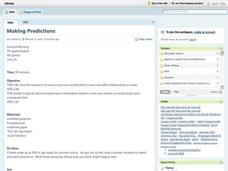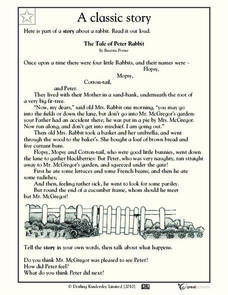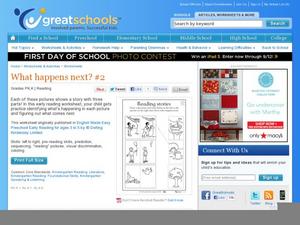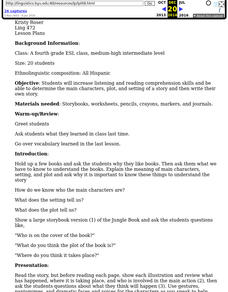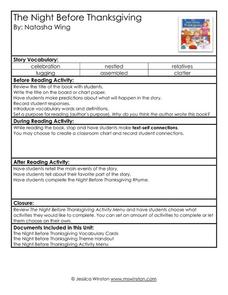Curated OER
The Rest of the Story
Third graders make predictions about the story "The True Story of the Three Little Pigs" based on background knowledge. They read the story, stopping to verify or reject predictions. They write their own opinionated fairytales.
Curated OER
Changing the End of a Story
Second graders re-write a story. In this alternate endings lesson plan, 2nd graders read Alexander and the Wind-Up Mouse, by Leo Lionni, stopping to discuss the events and predict what will happen next. Students work in groups to come up...
Curated OER
Making Predictions
Seventh graders read stories, stopping periodically to make predictions. They discuss how the sequence of events, as well as cause and effect, can give hints to the outcome of the story. In addition, 7th graders use logic and...
Have Fun Teaching
Predict and Infer (22)
Encourage close reading and critical thinking with a worksheet that asks readers to select an event from a story, predict what they believe will happen, and list clues from the story that support this prediction. After completing...
Curated OER
Dusty Locks and the Three Bears
Read this twist on Goldilocks and the Three Bears: Dusty Locks and the Three Bears by Susan Lowell. Kindergartners listen, predict, and discuss the story. They then participate in a dramatization of the story and draw a picture...
Curated OER
Reading Practice: Peter Rabbit
Oh, that naughty Peter Rabbit! Youngsters read an excerpt aloud from the classic Beatrix Potter story "The Tale of Peter Rabbit." They retell the story in their own words and discuss the events. Readers make inferences about various...
Curated OER
Going Graph-y
Second graders listen to and dicuss the story Where the Wild Things Are. They play a pantomime game and act out various feelings so their classmates can guess. They listen for the frequency of certain words, and record their findings on...
Curated OER
What Happens Next: 2
What happens next? That is a great question that requires learners to think about the sequence of events then make a prediction. They assess the pictures on the left and draw lines to the pictures on the right that show what will happen...
Houghton Mifflin Harcourt
Three Skeleton Key
Encourage your middle schoolers to interact with the text as they read. While reading "Three Skeleton Key," class members note predictions, define words and study their meanings, take notes on how the suspense builds, and jot down...
Curated OER
Where Do We Begin?
Primary learners grasp sequence of events by discussing morning routines and reviewing the story of Little Red Riding Hood. They explore the necessity of correct order of events. As a class, create a story with a beginning, middle, and...
Curated OER
Language Practice
The simple instructional techniques described in this plan will help young readers learn and practice basic reading skills and strategies. Before reading, introduce your readers to the meaning of main character, setting, and plot. Then...
Curated OER
ELD Lesson Plan: Courage
What is true courage? Your class can explore the answer with these three Houghton-Mifflin stories ("Hatchet," "Passage to Freedom," "Climb or Die," and "The True Confessions of Charlotte Doyle"), which feature courageous characters and...
Curated OER
Introduce: Comparison and Contrast
Class discussions can really make concepts come to life. The class discusses the differences between compare and contrast, read a book, then talk about ways they can compare events or characters in the story. Good leading question are...
Curated OER
Stone Soup
Students examine the topics of conflict, resolution, and solution using the book "Stone Soup." They create a class pictograph using real vegetables brought in by the students, answer story comprehension questions, and sequence the events...
Curated OER
Storytime
By reading two books aloud, Ben and Becky in the Haunted House and The Ghost in the Classroom, youngsters learn new words and understand story events. They workin small groups to review the vocabulary in a game-like setting.
Curated OER
Supporting Predictions With Text Evidence
Learners practice making and supporting a prediction with proof from a story. In this reading comprehension lesson, students read the book No Roses for Harry and make a prediction about the next event. Learners use evidence from the text...
Curated OER
Story Opening Two
In this proofreading a story beginning and writing the ending of the story worksheet, students read and proofread the beginning paragraphs of a story, study questions about predicting events and the characters, and write the story...
Curated OER
Story Retellings
Second graders complete story maps in order to retell stories to the class.
Jessica Winston
Gingerbread Friends Lesson Plan Guide
Full of activities for Jan Brett's story "Gingerbread Friends," this resource will get your kids in the mood for some snacks, fortify their need for vocabulary, and fill their minds with story elements.
Curated OER
The Night Before Thanksgiving
Natasha Wing's story The Night Before Thanksgiving is a great way to incorporate rhyme and literature into the Thanksgiving season. Learners make text-to-self connections, recall main events, and choose post-reading activities...
Jessica Winston
The Biggest Valentine Ever
Combine hearts with minds in a reading comprehension activity with a Valentine's Day theme. Steven Kroll's The Biggest Valentine Ever, named one of the best books for kids in 2014, provides kids with an opportunity to practice their...
Reed Novel Studies
Three Times Lucky: Novel Study
A car crash, a murder, a hurricane. With such a plot, why is the title of Sheila Turnage's novel Three Times Lucky? After making a prediction about the plot, scholars use the novel study to research and record facts...
Curated OER
Predictable Powers
Students use prior knowledge, the title, cover, and illustrations to make predictions about a story. They record their predictions on a Story Impression Worksheet, listen to the story, and check their predictions.
Curated OER
Making Predictions
Fourth graders explore making predictions while reading. They practice making predictions about stories they will read. Students discuss predictions and some of the details of a story. They write down their predictions and compare them...


